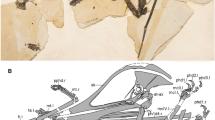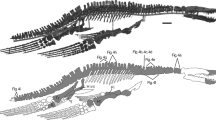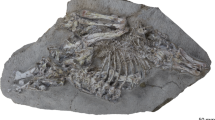Abstract
A new complete and fully articulated specimen of the anurognathid pterosaurAnurognathus ammoni from the Upper Jurassic Solnhofen Limestone of southern Germany provides new information about the species. The skull is broader than long and quite tall. The naris and antorbital fenestra are both small and anteriorly placed, whereas the orbit is very large. The palatal elements are slender struts of bone separating large openings. The tail is short, but is neither pygostyle-like nor like that of pterodactyloids. The wingfinger, unlike that of almost all pterosaurs, is reduced to three phalanges. Pedal digit V bears two long phalanges. Reexamination of the holotype specimen revealed evidence of bony bumps on the premaxilla and dentary that may have been associated with a fringe of bristles around the mouth.Anurognathus and the other anurognathids were probably adapted to aerial insectivory in low light conditions like extant caprimulgids and insectivorous bats, and may have spent little time on the ground. The taxonomy of the Anurognathidae is reviewed and new diagnoses are presented. A cladistic analysis supports the interpretation that the Anurognathidae is the sister-group to all other pterosaurs.
Kurzfassung
Ein neues vollständiges und zusammenhängendes Exemplar des FlugsauriersAnurognathus ammoni aus dem oberen Solnhofener Plattenkalk von Süddeutschland liefert neue Informationen über die Art. Der Schädel ist breiter als lang und ziemlich hoch. Naris und Praeorbitalöffnung sind klein und nach vorn versetzt, während die Orbita sehr groß ist. Die palatalen Elemente sind schlanke knöcherne Streben, die große Öffnungen trennen. Der Schwanz ist kurz, aber weder pygostyl noch vergleichbar dem der Pterodactyloidea. Im Gegensatz zu fast allen Flugsauriern besitzt der Flügelfinger nur drei Phalangen; Fuß-Zehe V besitzt zwei lange Phalangen. Die Neu-Untersuchung des Holotypus erbrachte den Nachweis von knöchernen Höckern auf Praemaxillare und Dentale, die mit einem Kranz von Borsten um den Mund verknüpft waren.Anurognathus und die übrigen Anurognathidae waren wahrscheinlich fliegende Insektenfresser bei Dämmerung und Dunkelheit wie heutige Caprimulgidae und insektenfressende Fledermäuse und dürften nur kurze Zeit am Boden verbracht haben. Die Taxonomie der Anurognathidae wird diskutiert, neue Diagnosen werden vorgestellt. Eine cladistische Analyse stützt die Annahme, dass die Anurognathidae die Schwester-Gruppe aller anderen Flugsaurier sind.
Similar content being viewed by others
References
Anonymous. 1988. The hairy dragons of western Mongolia. — New Scientist1630: 35.
Bakhurina, N.N. &Unwin, D.M. 1995. A survey of pterosaurs from the Jurassic and Cretaceous of the former Soviet Union and Mongolia. — Historical Biology10: 197–245.
Bennett, S.C. 1993. The ontogeny ofPteranodon and other pterosaurs. — Paleobiology19: 92–106.
Bennett, S.C. 1995. A statistical study ofRhamphorhynchus from the Solnhofen Limestone of Germany: Year-classes of a single large species. — Journal of Paleontology69: 569–580.
Bennett, S.C. 1996. Year-classes of pterosaurs from the Solnhofen Limestone of Germany: taxonomic and systematic implications. — Journal of Vertebrate Paleontology16: 432–444.
Bennett, S.C. 1999. Pterosaurs. — In:Singer, R., ed., Encyclopedia of Paleontology: 996–1004, Chicago.
Bennett, S.C. 2000. Pterosaur flight: the role of actinofibrils in wing function. — Historical Biology14: 255–284.
Bennett, S.C. 2001. The osteology and functional morphology of the Late Cretaceous pterosaurPteranodon. — Palaeontographica (A)260: 1–153.
Bennett, S.C. 2003a. Morphological evolution of the pectoral girdle of pterosaurs: myology and function. — In:Buffetaut, E. &Mazin, J.-M., eds., Evolution and palaeobiology of pterosaurs. — Geological Society London, Special Publications217: 191–215.
Bennett, S.C. 2003b. New crested specimens of the Late Cretaceous pterosaurNyctosaurus. — Paläontologische Zeitschrift77: 61–75.
Bennett, S.C. 2004a. New information on the pterosaurScaphognathus crassirostris and the pterosaurian cervical series. — Journal of Vertebrate Paleontology24 (Suppl. to 3): 38A.
Bennett, S.C. 2004b. New insights intoAnurognathus and the Anurognathidae. — Rivista del Museo Civico di Scienze Naturali “Enrico Caffi”, Bergamo 200322: 9–11.
Brown, G.W. 1986. Reassessment ofNyctosaurus. new wings for an old pterosaur. — Nebraska Academy of Sciences, Proceedings: 47 (abstract).
Dalla Vecchia, F.M. 1994. A new pterosaur (Reptilia, Peterosauria) from the Norian (Late Triassic) of Friuli (Northeastern Italy). Preliminary note. — Gortania. Atti del Museo Friulano di Storia Naturale16: 59–66.
Dalla Vecchia, F.M. 2002. Observations on the non-pterodactyloid pterosaurJeholopterus ningchengensis from the Early Cretaceous of northeastern China. — Natura Nascosta24: 8–28.
Döderlein, L. 1923.Anurognathus Ammoni, ein neuer Flugsaurier. — Sitzungsberichte der Mathematisch-Physikalischen Klasse der Bayerischen Akademie der Wissenschaften1923: 117–164.
Döderlein, L. 1929. ÜberAnurognathus Ammoni Döderlein. — Sitzungsberichte der Mathematisch-Naturwissenschaftlichen Klasse der Bayerischen Akademie der Wissenschaften1929: 47–63.
Jenkins, F.A.; Jr.Shubin, N.H.;Gatesy, S.M. &Padian, K. 2001. A diminutive pterosaur (Pterosauria: Eudimorphodontidae) from the Greenlandic Triassic. — Bulletin of the Museum of Comparative Zoology156: 151–170.
Jensen, J.A. &Padian, K. 1989. Small pterosaurs and dinosaurs from the Uncompahgre Fauna (Brushy Basin Member, Morrison Formation: ?Tithonian), Late Jurassic, Western Colorado. — Journal of Paleontology63: 364–373.
Ji Shu’an &Ji Qiang 1998. [A new fossil pterosaur (Rhamphorhynchoidae) from Liaoning.] — Jiangsu Geology22: 199–206 [in Chinese].
Ji Shu’an;Ji Qiang &Padian, K. 1999. Biostratigraphy of new pterosaurs from China. — Nature398: 573–574.
Kaup, J. 1834. Versuch einer Eintheilung der Säugethiere in 6 Stämme und der Amphibien in 6 Ordnungen. — Isis3: 311–315.
Kellner, A.W.A. 2003. Pterosaur phylogeny and comments on the evolutionary history of the group. — In:Buffetaut, E. &Mazin, J.-M., eds., Evolution and palaeobiology of pterosaurs. — Geological Society London, Special Publications217: 105–137.
Kuhn, O. 1937. Die fossilen Reptilien. — 121 p., Berlin (Borntraeger).
Kuhn, O. 1967. Die fossile Wirbeltierklasse Pterosauria. — 52 p., Krailling (Oeben).
Lü Junchang 2003. A new pterosaur:Beipiaopterus chenianus, gen. et sp. nov. (Reptilia: Pterosauria) from Western Liaoning Province of China. — Memoir of the Fukui Prefectural Dinosaur Museum2: 153–160.
Lü Junchang &Ji Qiang 2006. Preliminary results of a phylogenetic analysis of the pterosaurs from Western Liaoning and surrounding area. — Journal of the Paleontological Society of Korea22: 239–261.
Nopcsa, F. von 1928. The genera of reptiles. — Palaeobiologica1: 163–188.
Padian, K. 1980. Studies of the structure, evolution and flight of pterosaurs (Reptilia: Pterosauria). — Unpublished Ph.D. dissertation, Yale University. — xiv + 309 p.
Petronievics, B. 1928. Bemerkungen überAnurognathus,Döderlein. — Anatomische Anzeiger65: 214–222.
Riabinin, A.N. 1948. [Remarks on a flying reptile from the Jurassic of Kara-Tau.] — Akademia Nauk, Paleontological Institute, Trudy15: 86–93 [in Russian].
Smith, D.K.;Sanders, R.K. &Stadtman, K.L. 2004. New material ofMesadactylus ornithosphyos, a primitive pterodactyloid pterosaur from the Upper Jurassic of Colorado. — Journal of Vertebrate Paleontology24: 850–856.
Smith, J.B.;Harris, J.D.;Omar, G.I.;Dodson, P. &You Hailu 2001. Biostratigraphy and avian origins in northeastern China. — In:Gauthier, J. &Gall, L.F., eds., New perspectives on the origin and early evolution of birds: Proceedings of the International Symposium in Honor ofJohn H.Ostrom: 549–589 (Peabody Museum of Natural History, Yale University).
Swofford, D.A. 2003. PAUP* 4.0. — Sinauer Associates, Sunderland, Massachusetts.
Unwin, D.M. 2003. On the phylogeny and evolutionary history of pterosaurs. — In:Buffetaut, E. &Mazin, J.-M., eds., Evolution and palaeobiology of pterosaurs. — Geological Society London, Special Publications217: 139–190.
Unwin, D.M. 2006. The pterosaurs from deep time. — 347 p., New York (Pi Press).
Unwin, D.M. &Bakhurina, N.N. 2000. Pterosaurs from Russia, middle Asia and Mongolia. — In:Benton, M.J.;Shishkin, M.A.;Unwin, D.M. &Kurochkin E.N., eds., The age of dinosaurs in Russia and Mongolia: 420–433, New York (Cambridge University Press).
Unwin, D.M.;Lü Junchang &Bakhurina, N.N. 2000. On the systematic and stratigraphic significance of pterosaurs from the Lower Cretaceous Yixian Formation (Jehol Group) of Liaoning, China. — Mitteilungen aus dem Museum für Naturkunde in Berlin, Geowissenschaftlichen Reihe3: 181–206.
Wang Xiaolin;Kellner, A.W.A.;Zhonghe Zhou &Campos, D.A. 2005. Pterosaur diversity and faunal turnover in Cretaceous terrestrial ecosystems in China. — Nature437: 875–879.
Wang Xiaolin;Wang Yuanqing;Jin Fan;Xu Xing &Wang Yuan 2001. [Vertebrate assemblages of the Jehol Biota in western Liaoning, China]. — In:Wang Yuanqing &Deng Tao, eds., Proceedings of the Seventh Annual Meeting of the Chinese Society of Vertebrate Paleontology: 1–12, Beijing (China Ocean Press) [in Chinese].
Wang Xiaolin;Zhou Zhonghe &Zhang Fucheng 2002. A nearly complete articulated rhamphorhynchoid pterosaur with exceptionally well-preserved wing membranes and “hairs” from Inner Mongolia, northeast China. — Chinese Science Bulletin47: 226–230.
Wellnhofer, P. 1970. Die Pterodactyloidea (Pterosauria) der Oberjura-Plattenkalke Süddeutschlands. — Bayerische Akademie der Wissenschaften, Mathematisch-Wissenschaftliche Klasse, Abhandlungen141: 1–133.
Wellnhofer, P. 1974.Campylognathoides liasicus (Quenstedt), an Upper Liassic pterosaur from Holzmaden — The Pittsburgh specimen. — Annals of the Carnegie Museum45: 5–34.
Wellnhofer, P. 1975. Die Rhamphorhynchoidea (Pterosauria) der Oberjura-Plattenkalke Süddeutschlands. — Palaeontographica (A)148 (1–3): 1–33,148 (4–6): 132–186,149 (1–3): 1–30.
Wellnhofer, P. 1978. Pterosauria. — Handbuch der Palaeoherpetologie, Teil 19. — x + 82 p., Stuttgart (G. Fischer).
Wellnhofer, P. 1991. The Illustrated Encyclopedia of Pterosaurs. — 192 p., London (Salamander).
Wild, R. 1978. Die Flugsaurier (Reptilia, Pterosauria) aus der Oberen Trias von Cene bei Bergamo, Italien. — Bolletino della Società Paleontologica Italiana17: 176–256.
Wild, R. 1984. A new pterosaur (Reptilia, Pterosauria) from the Upper Triassic (Norian) of Friuli, Italy. — Gortania. Atti del Museo Friulano di Storia Naturale5: 45–62.
Wiman, C. 1923. ÜberDorygnathus und andere Flugsaurier. — Bulletin of the Geological Institution of the University of Upsala24: 23–54.
Wiman, C. 1928. Einige Beobachtungen an Flugsauriern. — Palaeobiologica1: 363–370.
Young, C.C. 1964. On a new pterosaurian from Sinkiang, China. — Vertebrata PalAsiatica8: 221–255.
Author information
Authors and Affiliations
Corresponding author
Rights and permissions
About this article
Cite this article
Bennett, S.C. A second specimen of the pterosaurAnurognathus ammoni . Paläont. Z. 81, 376–398 (2007). https://doi.org/10.1007/BF02990250
Received:
Accepted:
Issue Date:
DOI: https://doi.org/10.1007/BF02990250




